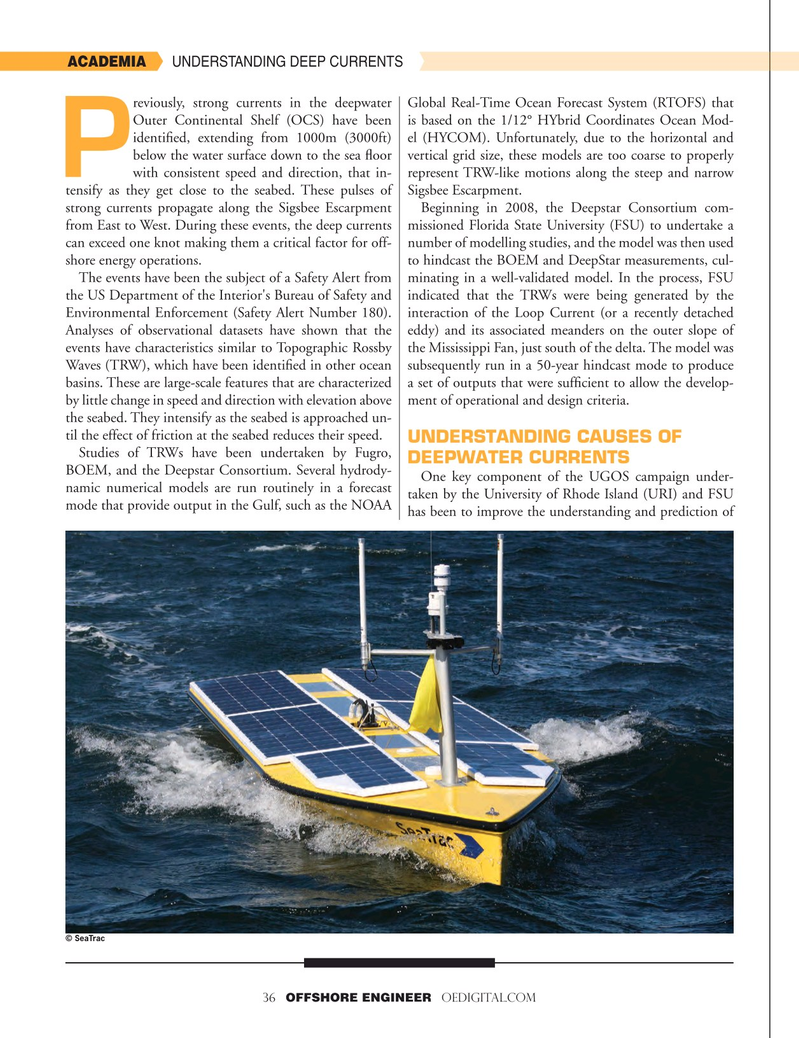
Page 36: of Offshore Engineer Magazine (Jul/Aug 2025)
Read this page in Pdf, Flash or Html5 edition of Jul/Aug 2025 Offshore Engineer Magazine
ACADEMIA UNDERSTANDING DEEP CURRENTS reviously, strong currents in the deepwater Global Real-Time Ocean Forecast System (RTOFS) that
Outer Continental Shelf (OCS) have been is based on the 1/12° HYbrid Coordinates Ocean Mod- identifed, extending from 1000m (3000ft) el (HYCOM). Unfortunately, due to the horizontal and below the water surface down to the sea foor vertical grid size, these models are too coarse to properly
P with consistent speed and direction, that in- represent TRW-like motions along the steep and narrow tensify as they get close to the seabed. These pulses of Sigsbee Escarpment.
strong currents propagate along the Sigsbee Escarpment Beginning in 2008, the Deepstar Consortium com- from East to West. During these events, the deep currents missioned Florida State University (FSU) to undertake a can exceed one knot making them a critical factor for off- number of modelling studies, and the model was then used shore energy operations. to hindcast the BOEM and DeepStar measurements, cul-
The events have been the subject of a Safety Alert from minating in a well-validated model. In the process, FSU the US Department of the Interior's Bureau of Safety and indicated that the TRWs were being generated by the
Environmental Enforcement (Safety Alert Number 180). interaction of the Loop Current (or a recently detached
Analyses of observational datasets have shown that the eddy) and its associated meanders on the outer slope of events have characteristics similar to Topographic Rossby the Mississippi Fan, just south of the delta. The model was
Waves (TRW), which have been identifed in other ocean subsequently run in a 50-year hindcast mode to produce basins. These are large-scale features that are characterized a set of outputs that were suffcient to allow the develop- by little change in speed and direction with elevation above ment of operational and design criteria.
the seabed. They intensify as the seabed is approached un- til the effect of friction at the seabed reduces their speed.
UNDERSTANDING CAUSES OF
Studies of TRWs have been undertaken by Fugro,
DEEPWATER CURRENTS
BOEM, and the Deepstar Consortium. Several hydrody-
One key component of the UGOS campaign under- namic numerical models are run routinely in a forecast taken by the University of Rhode Island (URI) and FSU mode that provide output in the Gulf, such as the NOAA has been to improve the understanding and prediction of © SeaTrac 36 OFFSHORE ENGINEER OEDIGITAL.COM

 35
35

 37
37